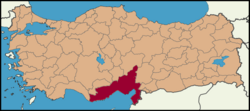Aleian plain
| Çukurova | |
|---|---|
| Region | |
 Location of Çukurova within Turkey |
|
| Coordinates: 36°52′N 35°29′E / 36.867°N 35.483°ECoordinates: 36°52′N 35°29′E / 36.867°N 35.483°E | |
| Country |
|
| Largest city | Adana |
| Provinces | Mersin, Adana, Osmaniye, Hatay |
| Area | |
| • Total | 38,585.16 km2 (14,897.81 sq mi) |
| Population (2015) | |
| • Total | 5,974,768 |
| • Density | 154.846/km2 (401.05/sq mi) |
| Time zone | EET (UTC+2) |
| • Summer (DST) | EEST (UTC+3) |
| Postal code prefixes | 33xxx, 01xxx, 80xxx, 31xxx |
| Area code(s) | 324, 322, 328, 326 |
Çukurova (Turkish pronunciation: [tʃukuɾova]), alternatively known as Cilicia, is a geo-cultural region in south-central Turkey, covering the provinces of Mersin, Adana, Osmaniye and Hatay. With a population of almost 6 million, it is one of the largest population concentrations in Turkey.
Çukurova in Turkish means roughly "Low Plain", çukur for "hollow, depression", ova for "plains". The region starts from Anamur at the west, extending east along the Mediterranean, stretching as far north as Tufanbeyli, wrapping around Gulf of İskenderun, turning south at Erzin and finally terminating at Yayladağı on the border of Syria. The core area is Çukurova plain (formerly Cilicia Pedias), covering the area of Mersin on the west, Kozan on the north, Osmaniye on the east and the Mediterranean on the south. Adana-Mersin Metropolitan Area is the business and cultural center of Çukurova.
Most of the Çukurova region is a large stretch of flat, fertile land which is among the most agriculturally productive areas of the world. Throughout history, Çukurova was a gateway from Europe to the Middle East and, being the shortest access point to the Mediterranean from the northern Middle East and Central Asia, it is a transportation hub, with its two major seaports and oil terminal.
The region's recorded history dates back over 6,000 years. Armenian presence in Cilicia dates back to the first century BC, when under Tigranes the Great, the Kingdom of Armenia expanded and conquered a vast region in the Levant. In 83 BC, the Greek aristocracy of Seleucid Syria, weakened by a bloody civil war, offered their allegiance to the ambitious Armenian king. During the Roman and early Byzantine Empires, the capital of Cilicia province was the important seaport of Tarsus, where Mark Antony met Cleopatra, and birthplace of Paul the Apostle and Theodore of Tarsus, among other important missionaries.
...
Wikipedia
